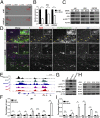BCL6 promotes glioma and serves as a therapeutic target
- PMID: 28356518
- PMCID: PMC5393201
- DOI: 10.1073/pnas.1609758114
BCL6 promotes glioma and serves as a therapeutic target
Erratum in
-
Correction for Xu et al., BCL6 promotes glioma and serves as a therapeutic target.Proc Natl Acad Sci U S A. 2017 May 23;114(21):E4317. doi: 10.1073/pnas.1706421114. Epub 2017 May 8. Proc Natl Acad Sci U S A. 2017. PMID: 28484026 Free PMC article. No abstract available.
-
Correction for Xu et al., BCL6 promotes glioma and serves as a therapeutic target.Proc Natl Acad Sci U S A. 2025 Mar 25;122(12):e2504152122. doi: 10.1073/pnas.2504152122. Epub 2025 Mar 20. Proc Natl Acad Sci U S A. 2025. PMID: 40112117 Free PMC article. No abstract available.
Abstract
ZBTB transcription factors orchestrate gene transcription during tissue development. However, their roles in glioblastoma (GBM) remain unexplored. Here, through a functional screening of ZBTB genes, we identify that BCL6 is required for GBM cell viability and that BCL6 overexpression is associated with worse prognosis. In a somatic transgenic mouse model, depletion of Bcl6 inhibits the progression of KrasG12V-driven high-grade glioma. Transcriptome analysis demonstrates the involvement of BCL6 in tumor protein p53 (TP53), erythroblastic leukemia viral oncogene homolog (ErbB), and MAPK signaling pathways. Indeed, BCL6 represses the expression of wild-type p53 and its target genes in GBM cells. Knockdown of BCL6 augments the activation of TP53 pathway in response to radiation. Importantly, we discover that receptor tyrosine kinase AXL is a transcriptional target of BCL6 in GBM and mediates partially the regulatory effects of BCL6 on both MEK-ERK (mitogen-activated protein/extracellular signal-regulated kinase kinase-extracellular signal-regulated kinase) and S6K-RPS6 (ribosomal protein S6 kinase-ribosomal protein S6) axes. Similar to BCL6 silencing, depletion of AXL profoundly attenuates GBM proliferation both in vitro and in vivo. Moreover, targeted inhibition of BCL6/nuclear receptor corepressor 1 (NCoR) complex by peptidomimetic inhibitor not only significantly decreases AXL expression and the activity of MEK-ERK and S6K-RPS6 cascades but also displays a potent antiproliferative effect against GBM cells. Together, these findings uncover a glioma-promoting role of BCL6 and provide the rationale of targeting BCL6 as a potential therapeutic approach.
Keywords: AXL; BCL6; NCoR; ZBTB; glioblastoma multiforme.
Conflict of interest statement
The authors declare no conflict of interest.
Figures






References
-
- Basso K, Dalla-Favera R. BCL6: Master regulator of the germinal center reaction and key oncogene in B cell lymphomagenesis. Adv Immunol. 2010;105:193–210. - PubMed
-
- Cattoretti G, et al. Deregulated BCL6 expression recapitulates the pathogenesis of human diffuse large B cell lymphomas in mice. Cancer Cell. 2005;7:445–455. - PubMed
-
- Phan RT, Dalla-Favera R. The BCL6 proto-oncogene suppresses p53 expression in germinal-centre B cells. Nature. 2004;432:635–639. - PubMed
Publication types
MeSH terms
Substances
Grants and funding
LinkOut - more resources
Full Text Sources
Other Literature Sources
Molecular Biology Databases
Research Materials
Miscellaneous

